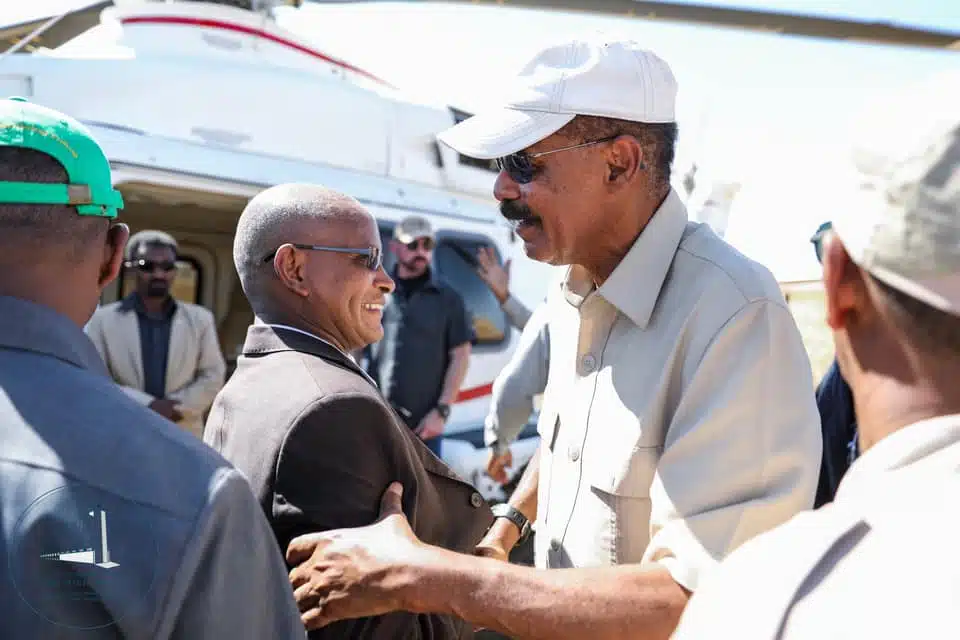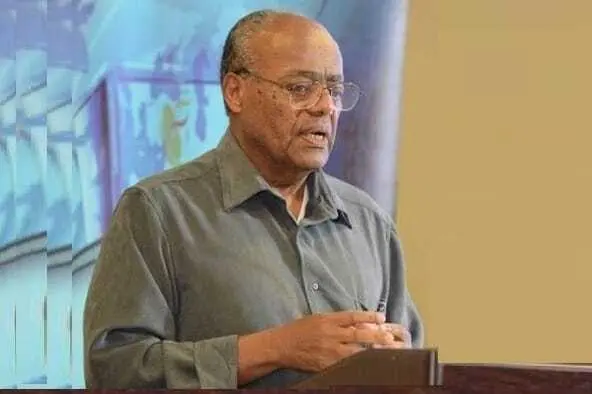 The horn of Africa is humming yet again with uncertainty as the relationship between Ethiopia and Eritrea sinks to an all-time low post the traumatic Tigray war of 2022. The tension is palpable, and the seeds of another conflict seem to be sowed with each passing day. Central to this brewing storm are divided Tigrayan leaders, suspended between their untoward loyalties to both Addis Ababa and Asmara. Will they become the catalyst for peace, or will they tip the scale towards another war? In this piece, we delve deeper into the intricate power dynamics at play and closely examine the consequences surrounding these looming questions.
The horn of Africa is humming yet again with uncertainty as the relationship between Ethiopia and Eritrea sinks to an all-time low post the traumatic Tigray war of 2022. The tension is palpable, and the seeds of another conflict seem to be sowed with each passing day. Central to this brewing storm are divided Tigrayan leaders, suspended between their untoward loyalties to both Addis Ababa and Asmara. Will they become the catalyst for peace, or will they tip the scale towards another war? In this piece, we delve deeper into the intricate power dynamics at play and closely examine the consequences surrounding these looming questions.
The Current State of Tigray Leadership
The current plight of Tigray leadership is a telling story of leaders caught in the web of geopolitical struggles, strained alliances, and deep-seated historical antagonisms.
Key Figures in Tigray Politics
Talking of Tigray politics, two figures undeniably stand out -Getachew Reda and Debretsion Gebremichael. The decisions they make have sweeping implications not only on Tigray, but also on Ethiopia, Eritrea, and the broader Horn of Africa.
Getachew Reda’s Role and Influence
Getachew Reda, serving as the President of the Tigray Independence Alliance (TIA), is a prominent figure in Tigray politics. His influence largely stems from his leadership role in the TIA and his articulate expression of Tigray’s aspirations for greater autonomy. He has been at the forefront of advocacy for Tigray’s rights in the face of rising tensions between Tigray, Addis Ababa, and Asmara. However, his stance has not been without controversy, as he faces criticism for his confrontational approach, which some argue, exacerbates the geopolitical disparities in the region.
Debretsion Gebremichael’s Leadership
Significantly, another key player in Tigray politics is Debretsion Gebremichael. As the TPLF president, his leadership has, in many ways, shaped the trajectory of Tigray’s political landscape. He is regarded as a relative moderate, often seeking diplomatic solutions to issues affecting Tigray. Yet, his more cooperative stance towards Addis Ababa and Asmara is met with mixed reactions, seen as a necessary compromise by some and deemed weakness by others. Ultimately, effectively managing this intricate balancing act poses significant challenges to his leadership.
Internal Divisions Among Tigray Leaders
Amid the mounting pressure from Ethiopia and Eritrea, the Tigray leadership finds itself more divided than ever. Divided ideologies and differing approaches towards dealing with Addis Ababa and Asmara have not only strained relationships within Tigray’s top brass but also among the populace. This internal friction erodes the cohesion necessary to forge a united front in the face of simmering tensions with Ethiopia and Eritrea.
Ethiopia’s Strategy Towards Tigray
Ethiopia’s tactics and strategies in dealing with the Tigray crisis have evolved significantly post the war. Understanding these is pivotal in offering insights into the current state and future direction of the Ethiopia-Tigray relationship.
Diplomatic Efforts by Addis Ababa
Ethiopia’s capital Addis Ababa has been working diligently behind the scenes to mend the strained relations with Tigray. The government’s approach has been primarily diplomatic, marked by a thrust on negotiations and peace talks. One such effort was the establishment of a round-table dialogue involving key Tigrayan leaders with a hope of bridging the widening political divide. However, the success of these dialogues remains a matter of debate among political analysts.
This diplomatic drive was accompanied by a strategic global communication campaign, the objective of which was to counter international criticisms and shape global opinion in Ethiopia’s favor. These diplomatic strategies, however, have been met with mixed reactions from both the domestic and international communities. Many argue that these measures are superficial, serving as mere smokescreens to mask deeper political divisions.
Economic Policies and Influence
Ethiopia’s economic policies towards Tigray have been two-pronged – aimed at both economic recovery and strategic influence. To assist Tigray’s post-war recovery, Addis Ababa has rolled out economic relief packages. These consist of agricultural aids, employment creation initiatives, and infrastructure rebuilding projects, aimed at alleviating the war-induced devastation.
On the other hand, the Ethiopian government has also sought to extend its influence over Tigray through economic measures. These include strategic control over key resources, imposition of economic sanctions, and conditional aids. While these measures are purportedly aimed at fostering economic dependence for political leverage, they have also been criticized for sparking economic hardship among Tigray’s populace.
In conclusion, Ethiopia’s strategy towards Tigray, marked by diplomatic efforts and economic policies, is a complex and multi-faceted one. As the scenario continues to evolve, it will be crucial to observe how these strategies shape the future of Ethiopia-Tigray relations. The stakes, undoubtedly, are high for both.
Eritrea’s Position and Influence
Eritrea’s stance toward internal affairs of Tigray leadership, and influence within the region offer an intriguing study of its political maneuvering.
Asmara’s Diplomatic Tactics
Eritrea, led by its capital Asmara, has been applying a series of sharp diplomatic tactics towards the Tigray conflict. Asmara’s diplomatic position has remained somewhat steady over the years, maintaining open channels of conversation with Tigray leaders. Using tact and subtlety, Asmara seems to strengthen its geopolitical standing, also using these tactics to leverage its regional ambition.
An important aspect that characterizes Asmara’s diplomacy is its unyielding stance on maintaining cross-border harmony. This involves close, yet cautionary, monitoring of the actions of Tigray leaders, coupled with efforts to maintain cordial relations with Addis Ababa.
However, it’s crucial to note that Asmara’s diplomacy is not without its critics. Some view its approach as an attempt to exploit the internal divisions among Tigray leaders while fostering favorable outcomes for Eritrean interests.
Military and Strategic Interests
Eritrea’s military and strategic interests in the Tigray region are another important dimension that shapes its overall posture. Eritrea has a vested interest in ensuring a stable Tigray region due to shared borders and intertwined histories.
On a strategic level, Eritrea perceives any instability in Tigray as a potential national security threat. The presence of militant factions and the risk of spillover effects compel Eritrea to take a proactive stance, while simultaneously navigating careful diplomacy.
However, it’s essential to mention that Eritrea’s strategic interests cannot invariably align with its diplomatic pursuits. This balancing act between diplomacy and strategy reveals the complexity of Eritrea’s position, drawing attention to the wider context of the Horn of Africa’s geopolitics.
Cautioning the potential pitfalls of its stance, Eritrea needs to balance its interests with the lived realities of the Tigray people, particularly considering the history of conflict and cooperation that characterizes the Eritrean-Tigrayan relationships. As the dynamics of power in Tigray continues to evolve, Asmara would need to reinvent its diplomatic and strategic approaches to adapt to these changes.
Potential Impact on Tigray
The volatile situation between Ethiopia, Eritrea, and the leadership of Tigray could have significant consequences. Among these consequences, they’re two critical areas to observe carefully: the risks tied to renewed conflict and possible future scenarios for Tigray.
Risks of Renewed Conflict
The post-war period in Tigray is a tense amalgamation of uncertainty and potential danger. Since the end of the war in Tigray in 2022, there has been an uneasy calm. However, with the dwindling relations between Ethiopia and Eritrea, the risk of another conflict is an omnipresent threat. The persisting tussle to win over the Tigrayan leaders adds another dimension of complexity to an already intricate situation.
If another conflict broke out, the repercussions could be catastrophic. The result would be an inevitable escalation in human suffering, extending the already existing humanitarian crisis. An influx of refugees, high civilian casualties, and a possible economic downturn could severely destabilize the region.
Future Scenarios for Tigray
There exist multiple future scenarios for Tigray, each with its distinct set of probabilities and consequences.
Prospects for Peace
Although the pathway to peace appears fraught with uncertainty, it’s indeed a plausible scenario, especially with international mediation. The keys to peace lie in diplomatic negotiations, trust-building measures, and economic cooperation. There’s a growing realization that rational dialogue and understanding could help alleviate tensions, bring about political reconciliation, and lead to a more secure and prosperous region.
Challenges in Political Reconciliation
However, achieving political reconciliation is a Herculean task. It requires acknowledging past atrocities, dealing with internal divisions, and building a unified front. The Tigrayan leaders, Getachew Reda and Debretsion Gebremichael, have disparate outlooks, causing a rift within the Tigray leadership. To reach political reconciliation, these leaders need to find common ground and address the concerns and expectations of the diverse groups they represent.
In essence, the future of Tigray teeters precariously on the cusp of peace and conflict. Navigating these challenges will demand prudent leadership, effective diplomacy, and the collective resolve to bring about peace and prosperity.
Africa Intelligence

